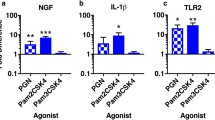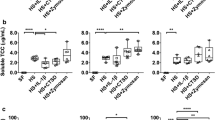Abstract
Purpose
Determine whether decorin is immuno-stimulatory to rat tail IVD cells and to characterize the mechanical consequence of inflammation at the whole rat tail IVD level.
Methods
Cultured rat tail annulus fibrosus (AF) cells were exposed to decorin, a resident IVD small leucine-rich proteoglycan (SLRP), with and without the presence of a toll-like receptor (TLR) 4 inhibitor, TAK-242. Resultant expression of pro-inflammatory cytokine and chemokines (MCP-1; MIP-2; RANTES; IL-6; TNFα) were quantified over 24 h. Whole rat tail IVD cultures (n = 50) were also treated with decorin (two concentrations: 0.5 and 5.0 μg/mL) with and without TAK-242 (via nucleus pulpous injection with a 33-gauge needle), and resultant mechanical properties were measured.
Results
AF cells exposed to decorin showed significant increases in pro-inflammatory cytokine and chemokine production; this was significantly blunted with the presence of TAK-242. Whole IVDs injected with decorin showed a dose-dependent decrease in neutral zone and tensile stiffness and an increase in neutral zone size. When TAK-242 was injected into the IVD with the decorin, mechanical stiffness was preserved and not different from sham controls (injected with PBS).
Conclusion
AF cells are capable of detecting decorin and inducing inflammation. Decorin further resulted in a functional deterioration in IVD mechanical integrity. TAK- 242, a TLR4 inhibitor, blunted chemokine production at the cellular level and preserved mechanical stiffness in the whole IVD.




Similar content being viewed by others
References
Gregory DE, Bae WC, Sah RL, Masuda K (2014) Disc degeneration reduces the delamination strength of the annulus fibrosus in the rabbit annular disc puncture model. Spine J 14:1265–1271
Lotz JC, Ulrich JA (2006) Innervation, inflammation, and hypermobility may characterize pathologic disc degeneration: review of animal model data. J Bone Joint Surg Am 88:76–82
Gabr MA, Jing L, Helbling AR, Sinclair SM, Allen KD, Shamji MF, Richardson WJ, Fitch RD, Setton LA, Chen J (2011) Interleukin-17 synergizes with IFNγ or TNFα to promote inflammatory mediator release and intercellular adhesion molecule-1 (ICAM-1) expression in human intervertebral disc cells. J Orthop Res 29:1–7
Hoyland JA, Le Maitre C, Freemont AJ (2008) Investigation of the role of IL-1 and TNF in matrix degradation in the intervertebral disc. Rheumatol 47:809–814
Rutges JP, Kummer JA, Oner FC, Verbout AJ, Castelein RJ, Roestenburg HJ, Dhert WJ, Creemers LB (2008) Increased MMP-2 activity during intervertebral disc degeneration is correlated to MMP-14 levels. J Pathol 214:523–530
Séguin CA, Pilliar RM, Roughley PJ, Kandel RA (2005) Tumor necrosis factor-alpha modulates matrix production and catabolism in nucleus pulposus tissue. Spine 30:1940–1948
Antoniou J, Steffen T, Nelson F, Winterbottom N, Hollander AP, Poole RA, Aebi M, Alini M (1996) The human lumbar intervertebral disc: evidence for changes in the biosynthesis and denaturation of the extracellular matrix with growth, maturation, ageing, and degeneration. J Clin Invest 98:996–1003
Molinos M, Almeida CR, Caldeira J, Cunha C, Gonçalves RM, Barbosa MA (2015) Inflammation in intervertebral disc degeneration and regeneration. J R Soc Interface 12:20141191
Jung YK, Park HR, Cho HJ, Jang JA, Lee EJ, Han MS, Kim GW, Han S (2019) Degrading products of chondroitin sulfate can induce hypertrophy-like changes and MMP-13/ADAMTS5 production in chondrocytes. Sci Rep 9(1):15846
Shu CC, Flannery CR, Little CB, Melrose J (2019) Catabolism of fibromodulin in developmental rudiment and pathologic articular cartilage demonstrates novel roles for MMP-13 and ADAMTS-4 in C-terminal processing of SLRPs. Int J Mol Sci 20(3):E579
Fuller ES, Shu C, Smith MM, Little CB, Melrose J (2018) Hyaluronan oligosaccharides stimulate matrix metalloproteinase and anabolic gene expression in vitro by intervertebral disc cells and annular repair in vivo. J Tissue Eng Regen Med 12(1):e216–e226
Melrose J, Smith SM, Fuller ES, Young AA, Roughley PJ, Dart A, Little CB (2007) Biglycan and fibromodulin fragmentation correlates with temporal and spatial annular remodelling in experimentally injured ovine intervertebral discs. Eur Spine J 16(12):2193–2205
Melrose J, Fuller ES, Roughley PJ, Smith MM, Kerr B, Hughes CE, Caterson B, Little CB (2008) Fragmentation of decorin, biglycan, lumican and keratocan is elevated in degenerate human meniscus, knee and hip articular cartilages compared with age-matched macroscopically normal and control tissues. Arthritis Res Ther 10(4):R79
Young AA, Smith MM, Smith SM, Cake MA, Ghosh P, Read RA, Melrose J, Sonnabend DH, Roughley PJ, Little CB (2005) Regional assessment of articular cartilage gene expression and small proteoglycan metabolism in an animal model of osteoarthritis. Arthritis Res Ther 7(4):R852–R861
Frey H, Schroeder N, Manon-Jensen T, Iozzo RV, Schaefer L (2013) Biological interplay between proteoglycans and their innate immune receptors in inflammation. FEBS J 280:2165–2179
Melrose J, Ghosh P, Taylor TKF (2001) A comparative analysis of the differential spatial and temporal distributions of the large (aggrecan, versican) and small (decorin, biglycan, fibromodulin) proteoglycan of the intervertebral disc. J Anat 198:3–15
Brown S, Melrose J, Caterson B, Roughley P, Eisenstein SM, Roberts S (2012) A comparative evaluation of the small leucine-rich proteoglycans of pathological human intervertebral discs. Eur Spine J 21:154–159
Schaefer L, Babelova A, Kiss E, Hausser HJ, Baliova M, Krzyzankova M, Marsche G, Young MF, Mihalik D, Götte M, Malle E, Schaefer RM, Gröne HJ (2005) The matrix component biglycan is proinflammatory and signals through Toll-like receptors 4 and 2 in macrophages. J Clin Invest 155:2223–2233
Imai K, Hiramatsu A, Fukushima D (1997) Degradation of decorin by matric metalloproteinases: identification of the cleavage sites, kinetic analyses and transforming growth factor-beta1 release. Biochem J 322:809–814
Moreth K, Iozzo RV, Schaefer L (2012) Small leucine-rich proteoglycans orchestrate receptor crosstalk during inflammation. Cell Cycle 11:2084–2091
Melrose J, Ghosh P, Taylor TK, Vernon-Roberts B, Latham J, Moore R (1997) Elevated synthesis of biglycan and decorin in an ovine annular lesion model of experimental disc degeneration. Eur Spine J 6(6):376–384
Takeuchi O, Akira S (2001) Toll-like receptors; their physiological role and signal transduction system. Int Immunopharmacol 1:625–635
Hartman RA, Bell KM, Quan B, Nuzhao Y, Sowa GA, Kang JD (2015) Needle puncture in rabbit functional spinal units alters rotational biomechanics. J Spinal Disord Tech 28:E146–E153
Michalek AJ, Funabashi KL, Iatridis JC (2010) Needle puncture injury of the rat intervertebral disc affects torsional and compressive biomechanics differently. Eur Spine J 19:2110–2116
Elliott DM, Yerramalli CS, Beckstein JC, Boxberger JI, Johannessen W, Vresilovic EJ (2008) The effect of relative needle diameter in puncture and sham injection animal models of degeneration. Spine 33:588–596
Gsell KY, Zwambag DP, Fournier DE, Séguin CA, Brown SHM (2017) Paraspinal muscle passive stiffness remodels in direct response to spine stiffness: A study using the ENT1-deficient mouse. Spine 42:1440–1446
Saggese T, Teixeira GQ, Wade K, Moll L, Ignatius A, Wilke HJ, Goncalves RM, Neidlinger-Wilke C (2019) Georg schmorl prize of the german spine society (DWG) 2018: combined inflammatory and mechanical stress weakens the annulus fibrosus: evidences from a loaded bovine AF organ culture. Eur Spine J 28(5):922–933
Bidanset DJ, Guidry C, Rosenberg LC, Choi HU, Timpl R, Hook M (1992) Binding of the proteoglycan decorin to collagen type VI. J Biol Chem 267:5250–5256
Melrose J, Smith SM, Appleyard RC, Little CB (2008) Aggrecan, versican and type VI collagen are components of annular translamellar crossbridges in the intervertebral disc. Eur Spine J 17:314–324
Gregory DE, Callaghan JP (2011) Does vibration influence the initiation of intervertebral disc herniation? An examination of herniation occurrence using a porcine cervical disc model. Spine 36:E225–E236
Khan AN, Jacobsen HE, Khan J, Filippi CG, Levine M, Lehman RA Jr, Riew KD, Lenke LG, Chahine NO (2017) Inflammatory biomarkers of low back pain and disc degeneration: a review. Ann N Y Acad Sci 10(1):68–84
Cunha C, Silva AJ, Pereira P, Vaz R, Gonçalves RM, Barbosa MA (2018) The inflammatory response in the regression of lumbar disc herniation. Arthritis Res Ther 20(1):251
Le Maitre CL, Pockert A, Buttle DJ, Freemont AJ, Hoyland JA (2007) Matrix synthesis and degradation in human intervertebral disc degeneration. Biochem Soc Trans 35:652–655
Colombier P, Clouet J, Hamel O, Lescaudron L, Guicheux J (2014) The lumbar intervertebral disc: from embryonic development to degeneration. Joint Bone Spine 18(2):125–129
Daly C, Ghosh P, Jenkin G, Oehme D, Goldschlager (2016) A Review of Animal Models of Intervertebral Disc Degeneration: Pathophysiology, Regeneration, and Translation to the Clinic. T Biomed Res Int: 5952165.
Singh K, Masuda K, An HS (2005) Animal models for human disc degeneration. Spine J 5(6 Suppl):267S–279S
Elliott DM, Sarver JJ (2004) Young investigator award winner: validation of the mouse and rat disc as mechanical models of the human lumbar disc. Spine 29(7):713–722
Acknowledgements
This work was funded by the Natural Sciences and Engineering Research Council of Canada (NSERC).
Author information
Authors and Affiliations
Corresponding author
Ethics declarations
Conflict of interest
The authors have no conflict of interest to disclose.
Additional information
Publisher's Note
Springer Nature remains neutral with regard to jurisdictional claims in published maps and institutional affiliations.
Rights and permissions
About this article
Cite this article
Zwambag, D.P., Molladavoodi, S., Guerreiro, M.J. et al. Immuno-stimulatory capacity of decorin in the rat tail intervertebral disc and the mechanical consequence of resultant inflammation. Eur Spine J 29, 1641–1648 (2020). https://doi.org/10.1007/s00586-020-06469-6
Received:
Revised:
Accepted:
Published:
Issue Date:
DOI: https://doi.org/10.1007/s00586-020-06469-6




